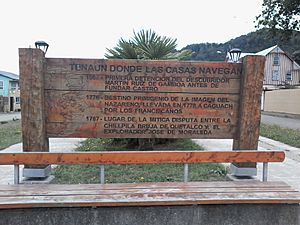José de Moraleda y Montero facts for kids
Quick facts for kids
José de Moraleda
|
|
|---|---|
| Born | 1750 Pasajes San Pedro, Spain |
| Died | 1810 Callao, Viceroyalty of Peru |
| Allegiance | |
| Service/ |
|
| Commands held | Moraleda Expedition |
| Signature | |
José Manuel de Moraleda y Montero (1750 – 1810) was a Spanish naval officer. He was also a skilled mapmaker. He is famous for exploring the Chiloé islands and other island groups in Patagonia during the late 1700s.
People in Chiloé sometimes thought he had special powers. He is still remembered as a sorcerer in local stories. A major waterway, the Moraleda Channel, is named after him.
Biography
José de Moraleda was born in 1750 in Pasajes San Pedro, a town in Spain's Basque country. His father, Manuel de Moraleda, was also a navy officer. José grew up in a family that knew a lot about ships and the sea.
When he was young, José Moraleda studied at the Royal School of Navigation in Cádiz. This training helped him become a naval officer. He later worked for Spain in its American colonies.
In 1786, Moraleda arrived at the Chiloé Archipelago. He was sent by the Viceroy (a powerful ruler representing the king) of Peru, Teodoro de Croix. His job was to help the local official, Francisco Hurtado del Pino, create accurate maps of the islands.
The maps Moraleda made of Patagonia were a big improvement. They were the best Spanish maps of western Patagonia since the Antonio de Vea expedition in the late 1600s.
In 1804, he reached the rank of "teniente de navío." This was a high rank for an officer in his field.
Moraleda passed away in 1810 in the port of El Callao, which was part of the Viceroyalty of Peru. He was 60 years old.
Legacy
Moraleda kept detailed diaries of his travels. He also drew many maps. His writings included notes about different cultures and coastal defenses. Some of his important diaries are:
- A journey to Callao, Peru, in 1772.
- A trip to explore the Chiloé Islands between 1786 and 1790.
- A journey from Callao to Chiloé, and then exploring the Chonos Archipelago and the Patagonian coast from 1792 to 1796.
- Journeys from Callao to Guayaquil and Panama, and exploring the coasts of Central America between 1803 and 1804.
Some of these works were later published by historians. Diego Barros Arana edited them in 1888. Later, Francisco Vidal Gormaz edited them again in the Chilean Navy's yearly reports on water and navigation.
The Moraleda Channel in Chile's Aysén Region is named after him. This honors his important explorations in the late 1700s. Other explorers, like Alessandro Malaspina, praised Moraleda's work and skills.
Books have also been written about Moraleda. Hugo O'Donell wrote El viaje a Chiloé de José de Moraleda (1787-1790) in 1990. Another essay, Moraleda, explorador del Pacífico insular, was published in 2010.
Legend of Moraleda as a Sorcerer
In the old stories of the Chiloé Archipelago, people believed Moraleda had magical powers. One famous story says he had a magic contest with a Huilliche witch named Chillpila. The legend says she made Moraleda's ship get stuck. In return, he supposedly gave her a book about European witchcraft.
Moraleda's own writings do not mention this magical duel. However, he did write that local witches and sorcerers thought he was "more machi (shaman), fortune teller, or sorcerer than all of them."
This mythical meeting with Chillpila is said to have happened in 1786. It later became an important story for a secret Huilliche group called La Mayoría or Recta Provincia.
See also
 In Spanish: José de Moraleda y Montero para niños
In Spanish: José de Moraleda y Montero para niños


